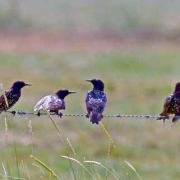LNG in South Africa
The new situation we have with comparatively cheaper LNG is sharpening our senses for new opportunities. This happens out of pain experienced by the producers as well as out of opportunistic endeavors in potential consuming markets. Either way, we are all happy takers and won’t look at the teeth too much – won’t we?
There is too much LNG around today so the LNG world has to get creative to sink those gargantuan volumes nobody seems to need.
New markets are needed and they are needed real quick. Countries that just months ago could not even remotely hope to become LNG importers should be very high on the list of exporters’ development targets.
Spotlight on South Africa.
The country is the economic powerhouse of the SADC region and one of the African heavyweights. As such it resides a bit lonely in a region where its peers are economically far less potent and hence stands on its own for many developments in this region as it cannot count on others to make the initial pushes for bigger, better, and cleaner.
Everyone looking at a world map of energy movements will quickly find that there is a huge white blob around the country. The entire African continent is an energy minnow with only some countries having developed some export industries but the import side and indeed, the internal energy markets are puny in comparison.
Moreover, South Africa still lives on the utility leftovers from the energy architecture that has been built under the reviled Apartheid regime. They built on autarky as the country was on bad terms with pretty much the entire planet. They tried to exploit whatever they could from their own country and limited imports.
This is all in a continent that has not been a big player on the world stage so far and has not developed big-style import infrastructure for almost anything. Look at it whatever way you want – that’s an odd position to be in. Nobody to share the pain of initial developments in a faraway region of the planet. It’s a bit like doing things on planet Mars.
BUT – this market needs energy like yesterday and this energy also needs to be cleaner than coal on which they have been feasting since the dawn of centrally produced electricity. South Africa is, in fact, a perfect case for LNG as LNG was first produced to connect producers with consumers that could not otherwise be connected through a steel pipe. The next meaningful gas reserves are located either in the north of Mozambique or in Angola which is still worlds away from the consuming centers. Besides, there have never been pipelines in this part of the world as pipeline laying and operating can be a challenge here.
By all means and purposes, South Africa is in a similar situation to South Korea as despite a land connection to would-be producers, it’s often a challenge to reach them. Making matters worse is a geographic position at the end of the world. South Korea lies in the middle of sprawling East Asia, a very powerful and economically thriving region of the world.
Put yourself into South Africa and you might be forgiven if you have an eerie feeling of isolation. All their neighbors are economic minnows compared to them, so they have no real peers to coast with.
In such a situation you might think that South Africa has all the incentives on earth to make itself look like a big, sweet ice cream on a hot summer day for LNG exporters. Except that, they don’t.
Anyone who ever tried to develop an energy project in the country will instantly know that navigating the numerous stumbling blocks set up by policymakers and the legislative environment is a bit like swimming with Crocodiles. You must do your swimming bit to advance but you must also watch out for their teeth in order not to become Crocodile fodder as this might hit you at any moment. The country has equipped itself with a very impressive armory of project-killing policies and tools that smack of North America or Europe.
Hard regulation erecting countless stumbling blocks and super long consultation processes dissuading anyone from taking a closer look at the country. Vocal political movements protecting special interests and trying to create jobs where none is necessary inflating payroll and operating expenses into Hindenburgesque proportions. Entrenched local players in a place with more systemic bottlenecks than a walk through a crowd of fans at an ACDC concert. And state-owned energy quasi-monopolies with bloated bureaucracies that must be cut into any deal one wants to make, ballooning costs even more.
Let’s face it. If you start a project there today, you might look at 10 years of Business Development before you come even close to something resembling an FID.
However, the country is also on its knees, energetically at least. Up until a year ago, high oil prices gave the government the lure of shale potential but that has firmly gone away since the oil price dropped to much less nauseating altitudes. Their existing refineries and synfuel plants are all leftovers from Apartheid and are creaking. The swelling population needs ever more energy. And this new energy cannot be as filthy as the old coal blocks anymore. South Africans have discovered the value of breathable air.
So, someone will have to chip in and make something happen.
A couple of companies are in the process of evaluating options. The best location for any import terminal would undoubtedly be Richards Bay as it is the gate to Kwa-Zulu Natal and also one of the closest ports to the economically important Gauteng region. The port is large and deep water and is used for large vessels. Besides, some really large electricity producers such as aluminum smelters are there and it’s also at the end of the only gas pipeline South Africa has bringing gas to the south.
This could be reversed leaving more gas in the economically important region in the north while supplying KZN with LNG. That’s a double whammy then. Besides, Transnet would surely appreciate the optimization revenue from such a deal.
There are other places and Capetown (or the nearby Saldhana Bay) sure provides some spectacular backdrop but the total market is much smaller. One might want to start with something big and splashy when he goes bringing LNG from far away.
South Africans have a choice now. They can take a leaf from other countries like South Korea and make LNG happen or dream on with their uneconomical floaters and get energy strangled in a world of cheap LNG.


















As an energy journalist that writes extensively on South African energy issues. A few points:
1. Richards Bay is good for the reasons you state, but also the Port of Saldanha to the north of Cape Town is a better prospect for investors than you state. Saldanha has been designated an economic development zone as part of a desire to decentralise the economy away from Jo’burg region. There are ongoing plans to convert nearby Eskom power plants from oil to gas, the local steel plant’s has invited to build a new independent power plant to be built. It is part of the growing Western Cape metropolitan region of 5.8 million inhabitants, of which Cape Town is the main city. There are economic, market, logistics, capacity, energy policy, power grid and growth reasons that s, make Saldanha a very desirable location to construct a combined LNG port, LNG bunkering, gas to power and distribution project for investors. In addition, Saldanha is being developed as an oil and gas hub. In addition, there is strong political support from the Western Cape government to build such a project. In addition, it would help aid in grid balancing challenges that the state utility Eskom faces operating the grid and would mean it would not have to build a new HVAC line into the region.
2. As for the regulatory region, the new oil and gas Act that is being passed through Parliament should prove a more realistic opportunity according to both government policy makers and investors I have talked to in South Africa. Prospects suggest the new regulatory regime will be more like the existing IPP (Independent Power Producers) program that exists for existing gas, wind and solar power plants.
3. As for Gauteng region, it must be remembered that it obtains much of its gas from a pipeline linking it with Mozambique gas fields. In addition, the existing pipeline is having its capacity doubled. It is also expected that this pipeline will in coming years be connected to new gas finds in the centre and north of Mozambique. As for the rest of South Africa, there is little in the way of a gas pipeline network.
4. At present several consortia are in the process of developing expressions of interest to submit to the government for both port by the end of July.
4. For more on South Africa’s energy sector read my website.
Nicholas, that’s what I call a comment. Thanks a lot.
1. I see your point on Saldanha Bay and Western Cape but I also remember how incredibly tough it was to work with the authorities there. The Port is in the middle of a nature reserve and as one resident there once told me, you can’t even spit in there. I was not endeared but I will always take your point on Capetown being a very interesting and thriving region that needs clean power. Maybe South Africa needs more than one LNG terminal after all. Don’t forget that whatever one does in Saldhana will be limited to Western cape only. Building pipelines from Saldhana to Gauteng does not make any economic sense. And the big stuff happens in Gauteng.
2. I will wait and see how this new oil and gas act is going to play within the very complex framework of SA laws and regulation especially with its myriad affirmative action programs that can be a real pain. My hopes are still strong.
3 The current gas pipeline was originally a diesel line and has been converted to gas. It’s utterly insufficient to serve the volumes of gas Gauteng would potentially need in order to counteract its energy deficiencies. A new build is in order. However, reversing the flow direction of the pipeline from South to North and leaving all the gas in Gauteng while also pumping from a terminal in the South (Richards Bay) could be done very quick and easy provided someone wants to take the initiative and also provides some gas education for South African players and institutions. The fields in the center and the north of Mozambique are very far off and connecting them to the pipe (which itself is way too small) is going to cost a lot of money. LNG in Richards Bay likely is a much quicker and cheaper option.
4 I have seen so many EIA’s in my life as a gas and LNG consultant, you can probably fill your apartment with them. Most of them remained dead words with no projects materializing afterward. A piece of paper by whatever reputable company is worth very little nowadays. They are getting signed on pure speculation. Let’s hope that for SA this is going to be different.
I will check up on your website. Thanks for your great work.
I expect several LNG to gas to Power plants will be built. Building a nationwide gas pipeline network is a long term goal. Instead, it is much easier to convert gas into electricity for onward distribution. Fortunately, the grid is being expanded to meet ongoing demand for power and the arrival of new power capacity from both Eskom and Independent Power Producers such as SASOL.
Makes a lot of sense. Building a hub with mid sized distribution would also make a lot of sense.